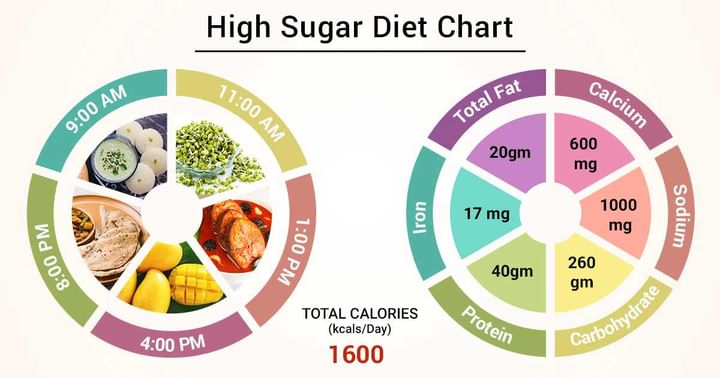Get the App
For Doctors
Login/Sign-up
About
Health Feed
Find Doctors
Diet Chart For high sugar
Last Updated: Jan 20, 2025
About
A high sugar diet aims at controlling the blood sugar levels in your body. A diet cannot lower blood sugar levels, only medication and exercise can help with that. However, a high sugar diet aims at preventing from blood sugar levels from rising further. Blood sugar levels can increase because of excessive carbohydrates such as bread, cereals, rice, pasta, milk and desserts. A high sugar diet plan focuses on the amount and type of carbs to be consumed in order to avoid over-eating and prevent poor dietary choices.
The fundamentals of a high sugar diet are as follows:
- Low-carb vegetables and greens – Consumption of vegetables such as zucchini, tomatoes, onions, eggplant and mushrooms is advised. To make them more flavoured, they can be eaten with low-fat dressings such as guacamole, hummus and salsa.
- Protein – Protein is essential for a well-balanced diet. It can be obtained from yogurt, cottage cheese, eggs and lean meats.
- Berries and melon – Berries and melon are low carb fruits that taste sweet, are filling and nutritious and are high in fibre. They can also be eaten with yogurt or ice cubes.
- Whole grain high-fibre foods – To prevent overeating, it is recommended to consume whole grain high fibre foods such as legumes (beans, peas, lentils) and pulses.
Diet Chart
| Sunday | |
| Breakfast (8:00-8:30AM) | 4 Idli + Sambar 1/2 cup/ 1 table spoon Green chutney/ Tomato Chutney |
| Mid-Meal (11:00-11:30AM) | green gram sprouts 1 cup |
| Lunch (2:00-2:30PM) | 3 Roti+1/2 cup salad + Fish curry ( 100 gm fish)+ 1/2 cup cabbage subji. |
| Evening (4:00-4:30PM) | 1 Portion fruit(Avoid high energy fruits. Eg: Banana, Jack fruit,Mango, Chikku.) |
| Dinner (8:00-8:30PM) | 2 Roti / chappati.+ Tomato subji 1/2 cup. |
| Monday | |
| Breakfast (8:00-8:30AM) | 2 Slice brown bread.+1 slice low fat cheese+1Boiled egg+ 1/2 cup low fat milk. |
| Mid-Meal (11:00-11:30AM) | 1 Portion fruit(Avoid high energy fruits. Eg: Banana, Jack fruit,Mango, Chikku.) |
| Lunch (2:00-2:30PM) | Veg pulav rice 1 cup+ 1/2 cup Soya Chunk curry+ 1/2 cup Low fat curd. |
| Evening (4:00-4:30PM) | 1 cup light tea+ 2 wheat rusk. |
| Dinner (8:00-8:30PM) | 2 roti/ Chapathi+ Ladies finger subji 1/2 cup. |
| Tuesday | |
| Breakfast (8:00-8:30AM) | Chappati 3 + 1/2 cup Potato green peas curry. |
| Mid-Meal (11:00-11:30AM) | 1/2 cup boilled black channa |
| Lunch (2:00-2:30PM) | 1 cup rice+ 1/2 cup Dhal+ Palak subji 1/2 cup+ 1/2 cup low fat curd. |
| Evening (4:00-4:30PM) | 1 Portion fruit(Avoid high energy fruits. Eg: Banana, Jack fruit,Mango, Chikku.) |
| Dinner (8:00-8:30PM) | Broken wheat upma 1 cup+ 1/2 cup green beans subji |
| Wednesday | |
| Breakfast (8:00-8:30AM) | Methi Parata 2+ 1 tbs green chutney. |
| Mid-Meal (11:00-11:30AM) | 1 Portion fruit(Avoid high energy fruits. Eg: Banana, Jack fruit,Mango, Chikku.) |
| Lunch (2:00-2:30PM) | 1 cup rice+ chicken curry( 150 gm chicken+ 1 cup cucumber salad. |
| Evening (4:00-4:30PM) | 1 Cup light tea+ Brown rice flakes poha 1 cup. |
| Dinner (8:00-8:30PM) | Wheat dosa 3 + 1/2 cup Bitter guard subji. |
| Thursday | |
| Breakfast (8:00-8:30AM) | Vegetable Oats Upma 1 cup+ 1/2 cup low fat milk. |
| Mid-Meal (11:00-11:30AM) | plane Yoghurt with raw vegetables / grilled vegetables -1 cup |
| Lunch (2:00-2:30PM) | 1/2 cup rice + 2 medium chappati+1/2 cup Kidney beans curry+ Snake guard subji 1/2 cup. |
| Evening (4:00-4:30PM) | 1 cup boilled channa+ light tea 1 cup. |
| Dinner (8:00-8:30PM) | 2 Roti/ chapati+ 1/2 cup mix veg curry |
| Friday | |
| Breakfast (8:00-8:30AM) | Mix veg Poha 1 cup+ 1/2 cup low fat milk. |
| Mid-Meal (11:00-11:30AM) | 1 Portion fruit(Avoid high energy fruits. Eg: Banana, Jack fruit,Mango, Chikku.) |
| Lunch (2:00-2:30PM) | 3 Chappati+ 1/2 cup cluster beans subji+ Fish curry(100g fish) 1/2 cup. |
| Evening (4:00-4:30PM) | 1 cup tea+ + 2 biscuits ( Nutrichoice or Digestiva or Oatmeal.) |
| Dinner (8:00-8:30PM) | 2 Roti / chappathi+Ridge guard subji 1/2 cup. |
| Saturday | |
| Breakfast (8:00-8:30AM) | Utappam 2+ 1 tbs green chutney. |
| Mid-Meal (11:00-11:30AM) | 1 cup boilled channa |
| Lunch (2:00-2:30PM) | 1 cup rice+ Soya chunk curry1/2 cup+ Ladies finger subji 1/2 cup+ small cup low fat curd. |
| Evening (4:00-4:30PM) | 1 Portion fruit(Avoid high energy fruits. Eg: Banana, Jack fruit,Mango, Chikku.) |
| Dinner (8:00-8:30PM) | Broken wheat upma 1 cup+ 1/2 cup green beans subji |
Food Items To Limit
- Grains - white rice, pasta, flour, white bread, cookies, cakes, muffins has to be avoided as they have high glycemic index which may increase your blood glucose levels.
- Protein - red meat (beef, pork, lamb), fried, high-sodium meats, poultry with skin, deep-fried fish, processed meats like bacon- high in saturated fat and sodium which may cause other co-morbidities such as heart disease and hypertension.
- Dairy - whole milk, full-fat yogurt, full-fat cottage cheese, full-fat sour cream, ice cream- high in saturated fat.
- Fruits & Vegetables - dried fruit, fruit drinks, fruit juice drinks, pickles, canned fruits with sugar syrup, regular jam, jelly, and preserves- high glycemic index which may increase your blood glucose levels.
- Fats and Sugars - butter, pastries, mayonnaise, french fries, potato chips, doughnuts, cakes and cookies- high in saturated fat and high glycemic index.
Do's And Dont's
Do's:
- Do eat Vegetables such as Spinach, tomatoes, cucumbers, broccoli, brussels sprouts, cauliflower, and asparagus. They’re packed with nutrients and low in carbohydrates, which your body quickly breaks down into glucose.
- Do eat whole-wheat bread and pasta, brown rice, and oats. Whole-grain starches give you more vitamins, minerals, and fiber than white or refined versions. They’re also less likely to lead to rapid spikes in blood sugar.
- Do eat small servings of peaches, apples, oranges, berries, kiwi, and other fruits. Fruit is a low-calorie, high-fiber, nutrient-rich source of carbohydrates.
- Do eat skinless poultry, fish, tofu, beans, and lean cuts of red meat.
- Do eat unflavored and low-fat yogurt, milk, and cheese. Low-fat dairy gives you protein, calcium, vitamins, and minerals in every serving.
Don'ts:
- Fried and breaded vegetables – they add extra calories, carbs, and fat.
- White bread, chips, and pastries, which quickly increase blood sugar.
- Jellies and fruit juices with added sugar.
- Full-fat dairy products. They come with extra calories and saturated fat, which raises LDL or “bad” cholesterol. Remember diabetes increases your risk of heart disease.
- Fatty cuts of meat and processed meat, like sausages and hot dogs.
Food Items You Can Easily Consume
- Cereals: Brown rice, Oat meal, Broken wheat, Ragi, Quinoa.
- Pulses: Chickpeas, Kidney beans, moong dal, masoor dal, soybeans.
- Vegetables: All gourds-bitter gourd, snake gourd, ridge gourd, bottle gourd, ivy gourd, ladies finger, tinda,green leafy vegetables.
- Fruits: Melons, apple, pine apple, papaya, citrus fruits, guava, berries etc.,
- Milk and Milk products: Skim milk, Paneer, Cottage Cheese, Yoghurt.
- Meat, Fish and Egg: Lean Meat, Skin out chicken, Tuna, Salmon, mackerel and sardines, egg white.
- Oil:
- 5 Tbsp/ day( Olive oil, Mustard Oil, Rice bran Oil, Canola oil
- Sugar: 2 Tsp/ day.
- Other beverages: Green tea.
References
- Nuttall FQ. Diet and the diabetic patient. Diabetes Care. 1983 Mar 1;6(2):197-207. [Cited 30 June 2019]. Available from:
- Fowler MJ. Diabetes treatment, part 1: diet and exercise. Clinical diabetes. 2007 Jul 1;25(3):105-9. [Cited 30 June 2019]. Available from:
- American Diabetes Association. Nutrition principles and recommendations in diabetes. Diabetes care. 2004 Jan 1;27(suppl 1):s36-. [Cited 30 June 2019]. Available from:
Book appointment with:
Delhi
Mumbai
Chennai
Bangalore
Index
Table of content
Content Details
Written ByDrx Hina FirdousPhD (Pharmacology) Pursuing, M.Pharma (Pharmacology), B.Pharma - Certificate in Nutrition and Child CarePharmacology
Reviewed By
Find Dietitian/Nutritionist near me
Ask a free question
Get FREE multiple opinions from Doctors
posted anonymously



